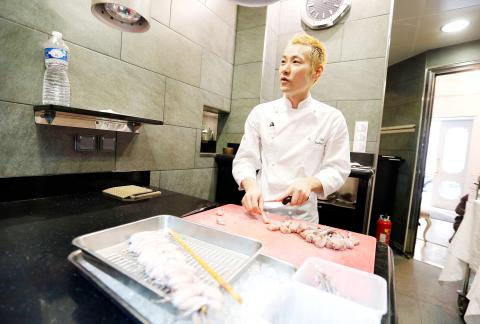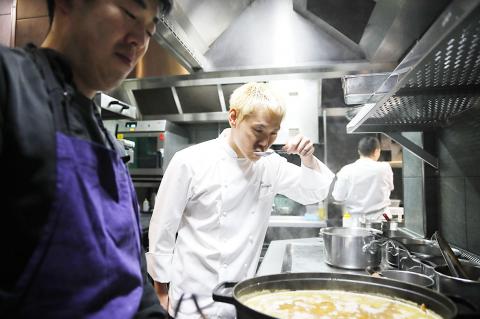Chef Kei Kobayashi is speaking his mind — something he says it took moving to France to learn.
Less than 24 hours after he became the first ever Japanese cook to win the maximum three Michelin stars in France, the phones are ringing off the hook at his Paris restaurant, Kei.
The last of the lunchtime diners are skipping out of his minimalist dining room not far from the Louvre, grinning from ear to ear.

Photo: AFP
They have just eaten a piece of history, and at 58 euros (US$63) for a set lunch, a bargain into the bag.
Kobayashi is holding forth in his clinically clean kitchen as his small team scurry around him.
“Japanese people are usually very quiet. But you cannot survive in France like that,” he said.

Photo: AP
The dozen or so other Japanese chefs who have been making waves in the rarefied world of French haute cuisine over the last few years are usually meekness incarnate.
They bow, say a few humble halting words of thanks and are off.
Not Kobayashi. The first thing that the 42-year-old said after getting his third star was how difficult and demanding he was.
With his gelled bleached blond hair, there is something of the showman about the young blade who readily admits to driving his cooks ferociously hard.
But it was not always so, he insisted, claiming France has changed him.
‘I SAY WHAT I MEAN’
“I am direct now. Like the French, I say what I mean,” he said.
“I am a very difficult guy,” he added, as he barked out an order in his small but perfectly designed kitchen. “Working with me means lots of stress. I watch and check everything.”
“Compared to a French chef” — who are not renowned for being touchy-feely — “I am probably more difficult,” he smiled.
But Kobayashi was careful not to ruffle feathers when asked if he and other young Japanese were beating the French at their own game and in their own back garden.
“France has accepted us and given us a place, so I thank France,” he said, adding that the Japanese cooks have been trained in the French tradition for nearly 150 years.
And indeed, it was watching a documentary about the nouvelle cuisine pioneer Alain Chapel that inspired Kobayashi to follow his father — a chef specialising in traditional Japanese kaiseki cuisine — into the kitchen.
Like his compatriot Yosuke Suga — who topped the La Liste’s ranking of the world’s best restaurants this year with his tiny Tokyo table, Sugalab, and who is only a few months his senior — Kobayashi decided to learn at the feet of his French heroes.
While some French gastronomes have implied that Kobayashi’s restaurant was not quite grand enough for the culinary holy grail of three stars, even the Michelin guide’s worst enemy believes its inspectors got it right.
French chef Marc Veyrat, who lost his third star last year and took Michelin to court in the notorious “Cheddargate” case, tipped his toque to him.
CRITICS ‘TRANSPORTED’
“I say ‘Bravo!’,” Veyrat said. “It’s great that people like him are coming here.”
Kobayashi, who was born in Nagano, opened his Paris restaurant nine years ago with his wife Chikako after working under a series of legendary French three-star chefs including Alain Ducasse, one of his mentors.
His pastry chef Toshiya Takatsuka — who has also been making a name for himself in France — said he decided to move to Paris to work under Kobayashi after eating at Kei in 2013.
“I could immediately feel the spirit of the chef, the concentration — everything was so absolutely right,” he said.
Working with him, however, is no bed of roses, he admitted.
“He puts you under the maximum pressure. He always tells the truth, he never hides things. He says what he thinks — there is no filter,” 35-year-old Takatsuka added.
“But I think he is harder on himself than he is on others... He has thought everything through in the restaurant, as he keeps saying, it’s a theater.”
And its star is Kobayashi’s cooking, with the dining room’s sparse grey interior designed to point up his startling creations like his “Garden of crunchy vegetables” which transported the Michelin inspectors.
When asked why there were no pictures on the walls, he replied, “My cuisine provides the necessary colour.” As Kobayashi mixes the salad of up to 40 ingredients covered in a citrus mousse, “in which every spoonful has a different taste,” it’s hard to disagree.

April 14 to April 20 In March 1947, Sising Katadrepan urged the government to drop the “high mountain people” (高山族) designation for Indigenous Taiwanese and refer to them as “Taiwan people” (台灣族). He considered the term derogatory, arguing that it made them sound like animals. The Taiwan Provincial Government agreed to stop using the term, stating that Indigenous Taiwanese suffered all sorts of discrimination and oppression under the Japanese and were forced to live in the mountains as outsiders to society. Now, under the new regime, they would be seen as equals, thus they should be henceforth

Last week, the the National Immigration Agency (NIA) told the legislature that more than 10,000 naturalized Taiwanese citizens from the People’s Republic of China (PRC) risked having their citizenship revoked if they failed to provide proof that they had renounced their Chinese household registration within the next three months. Renunciation is required under the Act Governing Relations Between the People of the Taiwan Area and the Mainland Area (臺灣地區與大陸地區人民關係條例), as amended in 2004, though it was only a legal requirement after 2000. Prior to that, it had been only an administrative requirement since the Nationality Act (國籍法) was established in

With over 80 works on display, this is Louise Bourgeois’ first solo show in Taiwan. Visitors are invited to traverse her world of love and hate, vengeance and acceptance, trauma and reconciliation. Dominating the entrance, the nine-foot-tall Crouching Spider (2003) greets visitors. The creature looms behind the glass facade, symbolic protector and gatekeeper to the intimate journey ahead. Bourgeois, best known for her giant spider sculptures, is one of the most influential artist of the twentieth century. Blending vulnerability and defiance through themes of sexuality, trauma and identity, her work reshaped the landscape of contemporary art with fearless honesty. “People are influenced by

The remains of this Japanese-era trail designed to protect the camphor industry make for a scenic day-hike, a fascinating overnight hike or a challenging multi-day adventure Maolin District (茂林) in Kaohsiung is well known for beautiful roadside scenery, waterfalls, the annual butterfly migration and indigenous culture. A lesser known but worthwhile destination here lies along the very top of the valley: the Liugui Security Path (六龜警備道). This relic of the Japanese era once isolated the Maolin valley from the outside world but now serves to draw tourists in. The path originally ran for about 50km, but not all of this trail is still easily walkable. The nicest section for a simple day hike is the heavily trafficked southern section above Maolin and Wanshan (萬山) villages. Remains of